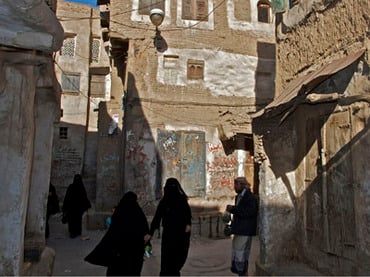Yemen’s Tattered Reality After ‘Fairytale’ Revolution: Photographic Perspectives

A year on from the Arab Spring, supposed to usher in a new era for Yemen, for most it is a perilous time. With no clear direction, it is plagued by instability and lawlessness, allowing it to fall prey to further US military expansion.
The unrest brought about by the Arab Spring triggered numerous political transitions throughout the Middle East and North Africa in 2011. In Yemen, the only state in the Arabian Peninsula to have a republican form of government, President Ali Abdullah Saleh was deposed after 33 years in power, and replaced by his deputy, Abd Rabbuh Mansur Hadi.
After nearly a year since this political transition, Yemen continues to face food insecurity, impoverishment and the threat of violent extremism from Al-Qaeda in the Arabian Peninsula (AQAP) and other Islamist militias. Guns are everywhere in the country’s capital, Sana’a, and several government ministries are abandoned and riddled with bullet holes. Once frequented by foreign tourists, political instability has left Yemen’s rich historical sites abandoned.
In the country’s sparsely-populated and oil-rich south, formerly known as the Democratic People’s Republic of Yemen, citizens of the once-communist state advocate separatism and independence from unified Yemen.
While many argue that 2011’s political transition failed to produce any tangible change in direction, the United States has backed the new administration and continues to implement a program of drone strikes in Yemen’s rural areas, despite reports of substantial civilian causalities. While the country continues to be plagued by instability and lawlessness, a cloud of uncertainty hangs over Yemen as Washington eyes to further increase its military presence in the Arab state.

A portrait of deposed President Ali Abdullah Saleh hangs from an abandoned government ministry in the Hassaba district in downtown Sana’a. (Photo by Nile Bowie)

Worshipers pass time in an alleyway nearby a mosque in the old city of Sana’a below flyers depicting Yemen’s current President Abd Rabbuh Mansur Al-Hadi. (Photo by Nile Bowie)

Property in downtown Sana’a has been deserted since being damaged in fighting between government forces and tribal militias during 2011’s unrest. (Photo by Nile Bowie)

Former President Saleh remains a revered figure among many the poor and merchant classes, as his photograph and propaganda can be seen hung in small businesses throughout the capital. (Photo by Nile Bowie)

Yemen’s derelict Ministry of Industry & Trade in ruins following the Arab Spring. (Photo by Nile Bowie)

Life has returned to normal in inner city communities almost a year after the ouster of President Saleh. (Photo by Nile Bowie)

The destruction of Yemen’s state-run Public Corporation for Agricultural Services and other institutions like it pose difficult challenges for Yemeni leadership in providing services and steering economic activity. (Photo by Nile Bowie)

The sale of Khat, an amphetamine-like stimulant and appetite suppressant, is the backbone of Yemen’s economy; users often chew leaves until their cheeks become enflamed. (Photo by Nile Bowie)

Economic activity in rural areas relies almost entirely on the cultivation and sale of Khat; an elderly man walks to the local Khat dealer in Wadi Dhahr. (Photo by Nile Bowie)

Scenes of urban poverty are commonplace in Sana’a, one of the oldest populated places in the world, as the Hadi administration struggles to enforce order. (Photo by Nile Bowie)

Beggars live in abandoned automobiles on the outskirts of Sana’a. (Photo by Nile Bowie)

The pristine Saleh Mosque, the largest and most modern mosque in the country, was constructed by Yemen’s former president and holds 40,000 people. (Photo by Nile Bowie)

Yemen’s Saleh Mosque has come under criticism for its apparent size and opulence; $60 million was spent on the mosque’s construction despite the nation’s austere poverty. (Photo by Nile Bowie)

A Yemeni solider examines photographs of victims of a suicide bombing that killed 90 people at a military parade rehearsal in Yemen’s capital in May 2012; Al-Qaeda in the Arabian Peninsula (AQAP) is accused of carrying out the attack. (Photo by Nile Bowie)

Customers sit outside a fish market on Socotra Island waiting for the day’s catch. (Photo by Nile Bowie)

A Socotran fisherman converses with a customer in Soqotri, an ancient unwritten language of pre-Islamic origin. (Photo by Nile Bowie)

In 2010, Yemen’s government allowed the United States to militarize Socotra Island to combat Somali pirates, despite the area being recognized by (UNESCO) as a World Natural Heritage Site for its biodiversity. (Photo by Nile Bowie)

Socotra has experienced the near-collapse of its tourism industry since 2011’s unrest; the island is located at the crossroads of strategic naval waterways and major oil transit routes through the Red Sea and the Gulf of Aden. (Photo by Nile Bowie)

The flag of the Democratic People’s Republic of Yemen painted on a roadside in Socotra reading, “Yes to the South!” (Photo by Nile Bowie)

Socotra is historically known for its rare and spectacular plant species, many with no equivalents available anywhere else in the world, such as the Dragon Blood tree. (Photo by Nile Bowie)

A nomadic girl sells sap from the Dragon Blood tree, which is used as a medicine among a variety of other things. (Photo by Nile Bowie)
Nile Bowie for RT
Nile Bowie is a Kuala Lumpur-based American writer and photographer. He explores issues of terrorism, economics and geopolitics.

